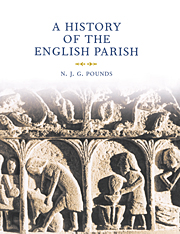Book contents
- Frontmatter
- Contents
- List of illustrations
- Preface
- List of abbreviations
- PART I THE ORIGINS OF THE PAROCHIAL SYSTEM
- PART II THE FUNCTIONS OF THE PARISH
- 5 The parish and its servants
- 6 The economics of the parish
- 7 The parish and the community
- 8 The parish and the church courts: a mirror of society
- 9 The parish church, popular culture and the Reformation
- PART III THE PARISH AND ITS CHURCH
- Notes
- Index
5 - The parish and its servants
Published online by Cambridge University Press: 29 July 2009
- Frontmatter
- Contents
- List of illustrations
- Preface
- List of abbreviations
- PART I THE ORIGINS OF THE PAROCHIAL SYSTEM
- PART II THE FUNCTIONS OF THE PARISH
- 5 The parish and its servants
- 6 The economics of the parish
- 7 The parish and the community
- 8 The parish and the church courts: a mirror of society
- 9 The parish church, popular culture and the Reformation
- PART III THE PARISH AND ITS CHURCH
- Notes
- Index
Summary
Vestries inherited the decaying functions
of manorial courts.
F. W. MaitlandThe parish, like the manor, had its institutions and its officers. The manor had its lord, his court and his steward; for its part the parish had its priest and, at least from the fourteenth century, its elected officials, churchwardens and synodsmen. To this nuclear group others were in the course of time added as the parish took on functions and obligations previously carried out by the manor. The two groups of officials – parochial and manorial – overlapped. The lord of the manor might be patron of the church; his steward might take his turn as churchwarden. But all the while the role of the parish was becoming more important, while, with the disappearance of labour dues, the enclosure of the open fields and the leasing of the demesne, the scope of the manor and its court was steadily diminishing.
The parish, as it evolved during the Middle Ages, came to have two contrasted groups of officers, the secular and the spiritual. Canon law was clear on the differences in function between them, and this was reflected and made obvious by the division of their responsibilities within the fabric of the church itself. Canon law enunciated no less clearly the doctrine that the spiritual hierarchy of the parish was the more exalted, and that it was the duty of the secular to obey and support it.
- Type
- Chapter
- Information
- A History of the English ParishThe Culture of Religion from Augustine to Victoria, pp. 155 - 199Publisher: Cambridge University PressPrint publication year: 2000



